#aangs outfit based on tibetan buddhist monks
Text

More avatar ! featuring kataang
#aangs outfit based on tibetan buddhist monks#kataras outfit based on inuit clothing#also i kinda love how i rendered their faces#kataang#katara#panukkie art#avatar the last airbender#my art#aang
682 notes
·
View notes
Text

I redesigned Yangchen's outfit!
... I actually designed a lot of outfits for her, because I am Extremely Normal about these books, and also I like costume design and learning about historical clothing.
Short disclaimer: These fantasy clothes aren't culturally or historically accurate, just historically and culturally influenced. I don't have any expertise in East or Central Asian culture or clothing, I've just been clicking around on the internet a lot the last two weeks learning things because that's my idea of fun lol. If you wanted to talk to people who actually know things you should check out @atlaculture or like @ziseviolet, both of whom's blogs I referenced while drawing.

I only designed two alternates for the outer robes. The first is based loosely off the robes Buddhist monks wear (loosely, because drawing draped fabric is hard ^^') especially the Tibetan zhen robe. This garment is just a long wide rectangle of cloth which can be draped across the body in lots of ways (versatility ftw!).
The other garment I drew is a Chuba, a traditional garment from Tibet and the Himalayas. It's a robe, but it highkey reminds me of kilts and hoodies, in that it a) can be worn over one or both shoulders or just as a skirt and b) it makes a giant pocket over the stomach. The long sleeves can be folded up or tied back btw.

I spent the most time on the middle layer, because I was thinking it has to be something she could comfortably fight in while also being suitable for diplomatic meetings, meditating, espionage, and possibly sleeping.
And like. You can fight and hike and whatnot in loose skirts, but it's annoying how twisted up they can get while sleeping. ALSO, YC does a lot of flying and leaping, so my girl needs pants. My faves are definitely the Xiaolin monk pants and the yellow wrap pants Aang wears. I tried dhoti (Indian wrap pants) because that kind of looks like what the giant statue of Yangchen meditating might be wearing, but I think it looks odd paired with a highwaisted shirt instead of a long tunic. Maybe I'll do some more drawings with her in a tunic and dhoti or a monk's dhonka and shemdap later, idk.

As any good historical fashion nerd knows, foundational garments are everything (◡‿◡✿).
But also, there's a scene where Yangchen and Kavik pretend to be lovers, and are "discovered" by a maid sleeping in the same room, with Yangchen in a state of partial undress (gasp!)
I am living for this fake drama; I need to know how scandalized the maid was lmao.
When the maid walks in, Yangchen immediately wraps herself in a bedsheet before ushering the maid back out the door. Maybe all she did was take off her outer robe... but why would she need to wrap herself in a sheet if she was wearing a long-sleeved high-necked gown? I got the sense from both the book and cursory research about buddhist monks that walking around without your outer robes was socially acceptable, at least in casual settings. I think it more likely she was in her underclothes, which historically (in the west anyway) would also double as sleeping clothes.
"The Aang" is censored because this is Tumblr-dot-com. Its mostly a joke, but also, I know other countries are less uptight about bººbies, so like, maybe it's a valid option ¯\_(ツ)_/¯
The ~Water Tribe~ look is based off Sokka's swimwear and not Katara's, mostly because chest binding seems antithetical to airbending.
All the other undergarment designs are based on hanfu neiyi, because that's what I could find reference photos and romanized names for.
I'm tired of typing now. Lemme know if you have questions about something, or want me to post a larger version of a specific outfit. I am open to feedback and tentatively open to requests.
#costume design#character redesign#Yangchen#avatar#airbenders#air nomads#avatar novels#chronicles of the avatar#atla#I realize now there are typos in the jpeg rip#too late to change it now
432 notes
·
View notes
Text

ATLA Gender Bender: "Aangi"
Aang -> Aangi
I have wondered where the name "Aang" originates from. It might actually be derived from the real name "Aangi". In any case, "Aangi" seems like the obvious choice for female Aang's name.
"Aangi" would have probably grown up at the Eastern Air Temple. She may have been frozen in ice while attempting to flee southward from the Eastern Air Temple.
I've been picturing Kiernan Shipka as the voice of "Aangi". Granted, I think Book 1 "Aangi" would sound more like Ikki, but by Book 3 she would sound like 12 year old Jinora.
OUTFITS:
1: Book 1 & 2 outfit
This outfit is designed to match the appearance of young Air nuns, shown in "The Rift".
For her hairstyle, I referred to several images, especially Erik Törner's "Tibetan girl in Shegar, Tibet" (see: www.flickr.com/photos/eriktorn…). I intended for Aangi's appearance to be symmetrical, and for her hair to be relatively short in Book 1, so that her hair could grow longer during the timeskip between Books 2 and 3. Unlike Ikki and Jinora, I wanted her hair to be tied in pigtails instead of buns. This allows her hair to be more expressive, and to flow freely in the wind. Her pigtails are meant to somewhat resemble the wings of a bird in flight. I also decided to have her pigtails tied underneath her ears. This is because Aang sometimes wears hats and other garments to hide his arrow. By tying her pigtails under her ears, this allows her hairstyle to be visible even when she has to hide her tattoo under a hat.
2: Book 1 & 2 undergarments
In real life, Buddhist nuns wear the same triple robe as the monks but with two additional layers, making it a "five-fold" robe (see: hayleyssilkroad.wordpress.com/…) These two additional layers are the sankakshika (undergarment, see: ia800908.us.archive.org/35/ite…) and udakasatika (bath robe, see: www.buddhanet.net/e-learning/h…).
The sankakshika "Aangi" wears in Books 1 and 2 is based on the sankakshika shown here: https://discourse.suttacentral.net/t/what-are-the-original-clothes-of-buddhist-nuns-sankacchika-video/23728/9. It extends from the chest to the navel, and is fastened by three brown, circular buttons found underneath the left armpit. Note that this is an undergarment, not a bath robe. She would not wear this while bathing or swimming, but would be seen wearing this during the Guru episode.
This undergarment would be destroyed by "Azulon"'s lightning in the Book 2 finale, forcing "Aangi" to replace it with an undergarment crafted from red Fire Nation cloth.
3: Aangi's Fire Nation disguise
4: Aangi's Fire Nation disguise, without headband
The three stray hairs on her forehead are a feature she shares with "Princess Zuka".
5: Book 3 outfit, with outer robes
Aang's Book 3 appearance is based on the Shaolin monks. As such, his female counterpart's appearance is based on the "Kung Fu Nuns of Nepal". In addition to their website and Facebook page, I referred to this image specifically: https://www.nbcnews.com/id/wbna49859526
"Aangi"'s robes feature the color red for two reasons. First, as an homage to the maroon robes worn by the "Kung Fu Nuns". It also makes sense as an in-universe explanation, as "Aangi" would have fashioned her new clothes during her stay in the Fire Nation, where most cloth is red.
By the end of Season 3, I think her hair would be much longer, and she would resemble a younger Yangchen.
6: Book 3 outfit, without outer robes
During the progress of the final fight with Ozai, "Aangi"s robes would burn away bit by bit, much like Aang's clothes. This costume would be visible in the middle of her fight with Firelord Ozai.
7: Book 3 outfit, Avatar State as seen in the finale
This undergarment replaces "Aangi"'s sankakshika. It provides similar coverage to Toph's bathing suit, and is somewhat similar to Katara's sarashi. This is how "Aangi" would appear by the end of her fight with Firelord Ozai.
8: Comics Aangi
This is a very similar costume to her Book 3 outfit.
Like what I’m doing? Consider leaving me a donation via Ko-Fi.
#aang#atla#atla genderbender#genderbend#genderswap#rule 63#my art#avatar the last airbender#my headcanons
12 notes
·
View notes
Text
Avatar: The Last Airbender Ethnicities:
I've noticed a few people have made modern headcanons based off of the ATLA characters' races & ethnicities, and a lot of them were very inaccurate based off of canon; so I'm going to explain which countries and cultures each of the four nations are based on.
The Air Nomads:
The Nomads' culture closely resembles mostly to that of Tibetan Monks and to Hindu priests to some degree. Their bald heads, clothing and meditation practices are very similar to those of real life Buddhist monks. The nomads practice vegetarianism like many real life Hindus and Buddhists. The method the monks used to find the Avatar, such as having toys for the child to choose from, is also the same method Tibetans used to find the Dalai Lama. Air temple architecture draws from real life Chinese Buddhist Pagodas. Aang’s mentor was named Monk Gyatso and Aang’s son, was named Tenzin, which form the real name of Tibet’s 14th and current Dalai Lama, Tenzin Gyatso.
Many airbenders wear saffron robes based off of those of Shaolin monks. The outfit Aang wears in season three is similar to that of the Dalai Lama.
The erratic and free style of air bending is based on ancient Chinese martial art of Ba Gua.
As for their architecture, it strongly resembles Pagoda Forest of China and Taktsang Temple of Bhutan (a Southern Asian country).
Their history also has a lot of real-world relevance, as the Air Nomad Genocide by Fire Nation is based off of an actual historical event, the Annexation of Tibet by the People's Republic of China.
Therefore, the closest ethnic group to the Air Nomads would be the Tibetan people, with a lot of Chinese influence.
Earth Kingdom:
The Earth Kingdom is the most diverse region of the Avatar world. Their architecture is almost soley influenced by those of China, but they also shares similar cuisine with China, such as roast duck and jook. Much of the clothing is based on the clothing of pre-manchu China, with the exception of Ba Sing Se, which is based on the Qing Dynasty. In addition, Korean clothing, such as hanbok, can be seen being worn by some characters as well. Architecture in the Earth Kingdom is very Chinese influenced in general.
The Earth Kingdom army uniforms resemble ancient Chinese military uniforms, particularly those of the Song and Ming Dynasty. The capital, Ba Sing Se, draws many parallels with ancient Chinese capitals such as Beijing.
Also, Kuei, the 52nd Earth King, resembles the the last emperor of China, Puyi. In appearance, both of them even wears circular glasses; and in culture, both rulers were kept ignorant of the state of their nation and had no real power. Kuei had previously never left the Ba Sing Se palace, akin to how Puyi, up to a point, was always kept in the Forbidden City.
The government also draws a parallel with the authoritarian Ming Dynasty with its propaganda and police state. It takes after China and the communist revolution. For example, Lake Laogai is named after the reeducation camps constructed by Mao Zedong; and the Dai Li is named after the leader of the Chinese Secret Police.
The sand benders in the desert also bear a resemblance to the Tuareg people in Northern Africa.
The strong stances and strikes of earthbending is based on ancient Chinese martial art of Hung Gar, although Toph’s specific style is inspired by Southern Praying Mantis style.
However, despite the Earth Kingdom's mostly Chinese influence, the Kyoshi warriors resemble Kabuki actors and geisha of Japan, and Kyoshi Island seems to hold more similarities to Japan tham China, as well.
Therefore, the people of Ba Sing Se would be Chinese, and since the Kingdom was formed around Ba Sing Se as their Capital, so would the majority of the Earth Kingdom as well. There are two excepts, though, with those who live on Kyoshi Island, who would be mixed of Japanese and Chinese ancestry. Along with that, the sand benders would be Tuareg, as it's the only part of their culture we've seen.
The Fire Nation:
The mainstream Fire Nation culture closely resembles mostly Japan and China to some extent. Their architecture strongly resembles Chinese architecture, and their army wears ancient uniform of Chinese military.
As for their real-world similarities, as previous stated in the Air Nomad's history, their invasion on Air Temples, were quite similar to real life invasion of Tibet by People’s Liberation Army of China.
As for the Fire Nation’s similarities with Japan, they're mostly based off of Imperial Japan. This includes them being an extremely militaristic and industrialized country in only a few decades, and being the expansionist nation compared to others. Their propaganda justifying their imperialism is similar to that of Japan’s propaganda during World War II, as they used to justify their invasion on rest of the S.E. Asia.
The Fire Nation is influenced by other Chinese and Southeast Asian cultures as well. The Fire Nation’s topography is also similar to Japan, Hawaii, and Polynesian Islands. Ancient Egyptian and Chinese architecture inspired the Fire Nation Royal Palace and the royal garden is similar to classical Chinese ones. The Palace is visually similar to the Forbidden City but to a lesser extent. The Fire Temple is based on Chinese pagodas. However, Ember Island draws from Southeast Asian resorts, which can be seen in the numerous paintings and vases in the homes.
Chinese influences can be seen in Fire Nation attire. In particular, Zuko can be seen wearing a shenyi, a historical Chinese clothing.
Warlord era of the Fire Islands (an era before Fire Lord uniting the islands into single nation) were based on the Ainu culture of Japan and Russia.
The Sun Warriors were known for worshipping the sun since they drew their power from it, similar to Mayan and Aztec cultures, who also glorified the sun. Their clothing is very similar to traditional Southeast Asian warrior dress, most notably, their headdresses. Sun Warriors’ buildings are reminiscent of Mesopotamian and Southeast Asian architecture, such as the Phanom Rung and Angkor Wat.
Therefore, the Fire Nation's people could be seen as either Chinese or Japanese, as both of their culture is very prevalent. Due to the Earth Kingdom's people already being based off of China, I personally see the Fire Nation as Japanese. However, as previously stated, the Sun Warriors are mostly likely a mixture of Japanese and Southern Asian Indigenous descent.
The Water Tribe:
As seen on maps in ATLA, the north and south Water Tribes are positioned on the coldest extremes, similar to the real life tribe of the Inuit, who are a nation of many communities in Arctic & Subarctic regions in Russia, the US, Canada, & Greenland.
As for cultural similarities, Katara and other women in the Southern Water Tribe are seen wearing hair loops, which are actually hairstyles worn by Inuit women. There are also igluvijait (snow houses) in Katara and Sokka’s Southern Water Tribe village, and iglu/igluit means any kind of house in many Canadian Inuktitut dialects. Water Tribe members are also seen wearing anorak clothing, which was originally worn by the indigenous peoples of the Arctic designed to keep them warm and protected from harsh weather.
Their fighting style is based off of Chinese Tai-Chi. The Australian Aboriginals' weapons, such as the boomerang, can be seen being used by Water Tribe warriors, most notably Sokka. Face Paint, as seen being wore by the Water Tribe members, is also more common among Native American tribes; whereas tattoos are more common in Inuit culture. Water Tribe ships resemble Polynesian catamarans.
Different cultures inspired Water Tribe architecture based on their geography. The Northern Water Tribe’s architecture pulls from the ancient Aztecs’ pyramids and Venice’s canal systems while the Southern Tribe’s igloos mirror those of the Inuit.
Native American, Chinese and Japanese myths even influenced Water Tribe spiritual practices. For example, the moon and ocean spirits, Tui and La, are reminiscent of the Chinese legend of Yin and Yang.
For real-world similarities, Avatar has used modern disputes; such as the conflict over oil and ‘progress’ in the the graphic novel Avatar: The Last Airbender—North and South has been taken straight from conflicts in Inuit territory in Alaska.
Therefore, it makes sense to have both of the tribes be mostly made up of Inuit people. I personally view the Southern Water Tribe as being Inuit, and the Northen Tribe as being a Yup'ik due to the mixed influences.
Reminder: This is all based off of my own personal research, along with what other people have noticed as well, and my opinions because of it. My purpose for making this was to avoid white-washing that happens in the fandom, and to hopefully help educate others. If any information is wrong, feel free to correct it!
#avatar the last airbender#avatar#atla#atla meta#atla analysis#fire nation#air nomads#earth kingdom#ba sing se#northern water tribe#southern water tribe#water tribe#earth bender#water bender#fire bender#air bender#katara#aang#sokka#toph#zuko#toph beifong#aloeverants
161 notes
·
View notes